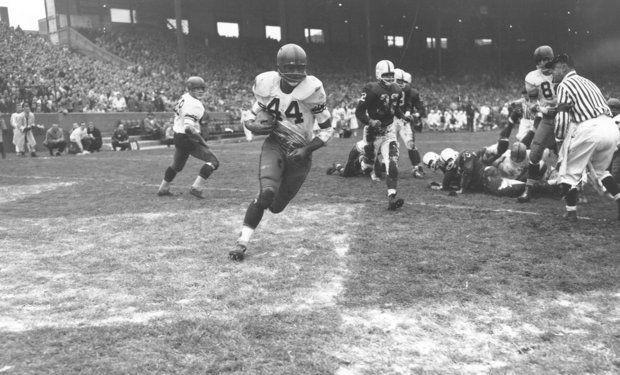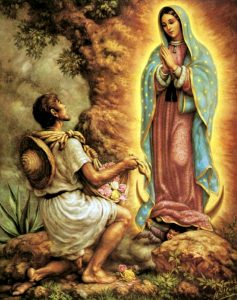Ernie Davis is remembered as one of the most dynamic running backs in NCAA football history. Overcoming adversity is something he had been doing since the time he was born in 1939 in his hometown of New Salem, Pennsylvania. A few days after Ernie was born, his father passed away and his mother was not in the condition to take care of her newborn child. So, Ernie was raised by his maternal grandparents in Uniontown, Pennsylvania. Growing up, Ernie had a bad stuttering problem leaving it hard for him to communicate with others, but his grandparents helped him cope with it and managed to instill strong faith and discipline in him. When Ernie turned twelve, his mother returned back to his life and had him move to Elmira, New York. As Ernie grew older, people all around town began raging about Ernie “the Elmira Express” Davis and his dynamic football skills. He was actively recruited by dozens of colleges. But swayed by his hero Jim Brown, he was convinced to attend the University of Syracuse.1

When Ernie Davis arrived at Syracuse in 1958, his welcome was anything but warm. His own teammates would beat him and target him in practice. There was an incident where a defensive player threw Ernie to the floor and beat him until the coaches pulled him off of Ernie. But, Coach Floyd Benjamin “Ben” Schwartzwalder pushed very hard to get the team to play as one and respect each other as a team rather than hate each other because of the color of their skin. Once Ernie became adapted to the school, and once his teammates warmed up to him, he was moved up to varsity. This was when Coach Schwartzwalder began to shape the young Ernie Davis into the Elmira Express that he would forever be remembered as. In practice, he quickly adapted to this collegiate level and was named the new starting running back for the season to come.2

After Syracuse finished the 1959 season with a respectable record of 8-2 and finishing tenth in the nation, many were hopeful for what the future held for the Fighting Orangemen. So, at the start of the 1960 football season, there were high expectations for both the young Ernie Davis and the Syracuse Fighting Orangemen.3 The Coaches and Boosters of the university questioned whether or not Davis would be able to fill the shoes of future Hall of Famer Jim Brown, and many wondered whether he could lead Syracuse to their first National Championship victory. Ernie Davis and the Fighting Orangemen hit the ground running and went undefeated in the regular season beating nine teams by over a twenty-one point margin.4
The regular season would be nothing compared to what they were going to face in the 1960 Cotton Bowl. The night before the highly anticipated game, Ernie and his team arrived in Dallas, and the hotel they made reservations at refused to let Ernie and two other teammates stay in the main part of the hotel. That night Ernie had to stay in the basement level of the hotel where he woke up to a pile of death threats and letters telling him not to compete in the Cotton Bowl. In fear of a violent outburst at the game, the Mayor of Dallas, Robert Lee Thornton, sent snipers to the stadium in an effort to try to ensure peace during the game.5
The moment of truth had finally come for the Orangemen, and it was time for the Elmira Express to lead his team to a National Championship victory at the Cotton Bowl. From the moment the ball was kicked off it was clear that Davis was playing on another level, as he averaged 7.8 yards per carry. As the game progressed, Ernie started getting beat up after plays, particularly in dog piles, and they gradually got worse. Tensions between the two teams were rising. Ernie Davis was beaten so badly after one play that he had to be escorted to the locker room so a doctor could look at his already injured hamstring. But, Davis would later be returned to the game, after going against what the doctor had suggested, which was to sit out the rest of the game and take it easy. Halftime was approaching and the score was 15-0. Syracuse was up and the aggression and altercations began to get worse. Then: “John Brown, a Negro lineman, played nose to nose against 235-pound Texas tackle Larry Stephens. To goad him off balance, Brown claimed, Stephens kept calling him ‘a big black dirty nigger.’ Finally, Brown warned him not to call him that again. When Stephens did, Brown swung.”6 That punch exploded into an all-out brawl between Texas and Syracuse, which would come to be known as “The Battle of the Hard-Noses.” Syracuse eventually went on to win the Cotton Bowl and claim their first National Championship in school history.7
The 1961 season came, and Ernie Davis just kept getting better. That season, he averaged 7.8 yards per carry and ended up breaking the school record for touchdowns in a single season. Everyone in the country was watching The Elmira Express shatter records and continue to carry his team to victory. The Fighting Orangemen would end up finishing the season 8-3, and finished sixteenth in the country and won the Liberty Bowl.8 Once the Season was concluded, the press and people began to discuss the Heisman Trophy Ceremony. Even President John F. Kennedy sent Ernie Davis a telegram commending him on fighting and competing in a sport he loved, and wished him luck in his NFL career and the upcoming Heisman Trophy Ceremony. Although the president was very supportive of young Ernie Davis, much of the country still made it hard for Davis to go places or be normal. There were many reports that he had still been receiving death threats constantly since the Cotton Bowl. There was even an incident where people were throwing food at him in public while he was on a run in the weeks leading up to the Heisman.9

For many years, African-American players weren’t even considered for the Heisman Trophy. Even the NFL Hall of Famer and Ernie Davis’s hero, Jim Brown, was nominated and clearly deserved the Heisman in 1958. When the day of the Heisman Trophy Ceremony had finally arrived, there was still no clear candidate that stuck out as the next Heisman trophy winner. So who would win was still very unclear to the country. But in 1961, Ernie Davis became the first African American to win the Heisman Trophy, and JFK was there to present the trophy to him personally. This event gave the Civil Rights movement momentum, and helped Americans begin to see that this concept of equality could be achieved.10
After winning the Heisman Trophy, Ernie Davis was prepared for the All-American game and was drafted by the Cleveland Browns as the first overall pick in the 1962 NFL draft. One day, while at practice, Davis passed out and laid unconscious on the field, and was rushed to the hospital. He was placed in the hospital for an extended period of time, and the doctors ran numerous tests on him. After this time, he was eventually released from the Cleveland Browns because they discovered that he had been diagnosed with leukemia.11
On May 18, 1963, Ernie the Elmira Express Davis died. Ernie Davis changed the game of football; he was the first African American to win the Heisman and be the first pick in the NFL draft. Davis never said much, but he led by action, and made change through action. He became an inspiration to a lot of people in American society and refused to ever let the color of his skin hold him back from chasing his dreams. He will forever be remembered for that.12
- Eric Quackenbush, “Ernest ‘Ernie’ Davis: The Elmira Express,” Bleacher Report, June 24, 2009. Accessed February 7, 2018. http://bleacherreport.com/articles/205915-ernest-ernie-davis-the-elmira-express. ↵
- Brad Kelly, “Ernie Davis, Uplifting Champ Rush To The Top: He led Syracuse to the national title before his young death,” Investors Business Daily, December 14, 2009. Accessed January 29, 2018. ↵
- Eric Quackenbush, “Ernest ‘Ernie’ Davis: The Elmira Express,” Bleacher Report, June 24, 2009. Accessed February 7, 2018. http://bleacherreport.com/articles/205915-ernest-ernie-davis-the-elmira-express. ↵
- Eric Quackenbush, “Ernest ‘Ernie’ Davis: The Elmira Express,” Bleacher Report, June 24, 2009. Accessed February 7, 2018. http://bleacherreport.com/articles/205915-ernest-ernie-davis-the-elmira-express. ↵
- Ben Cosgrove, “LIFE at the 1960 Cotton Bowl: ‘Battle of the Hard-Noses’,” Time, January 2, 2014. Accessed January 29, 2018. http://time.com/3878581/cotton-bowl-1960-when-syracuse-whipped-texas-forthe-national-title/. ↵
- Ben Cosgrove, “LIFE at the 1960 Cotton Bowl: ‘Battle of the Hard-Noses’,” Time, January 2, 2014. Accessed January 29, 2018. http://time.com/3878581/cotton-bowl-1960-when-syracuse-whipped-texas-forthe-national-title/. ↵
- Ben Cosgrove, “LIFE at the 1960 Cotton Bowl: ‘Battle of the Hard-Noses’,” Time, January 2, 2014. Accessed January 29, 2018. http://time.com/3878581/cotton-bowl-1960-when-syracuse-whipped-texas-forthe-national-title/. ↵
- Eric Quackenbush, “Ernest ‘Ernie’ Davis: The Elmira Express,” Bleacher Report, June 24, 2009. Accessed February 7, 2018. http://bleacherreport.com/articles/205915-ernest-ernie-davis-the-elmira-express. ↵
- Eric Quackenbush, “Ernest ‘Ernie’ Davis: The Elmira Express,” Bleacher Report, June 24, 2009. Accessed February 7, 2018. http://bleacherreport.com/articles/205915-ernest-ernie-davis-the-elmira-express. ↵
- Sean Krist, “Ernie Davis and JFK: More than 50 years ago, key figures in D.C. football time of change,” Syracuse.com, August 20, 2o14. Accessed February 21, 2017, http://www.syracuse.com/kirst/index.ssf/2014/08/ernie_davis_and_jfk_more_than_50_years_ago_key_figures_in_another_dc_football_ca.html. ↵
- Eric Quackenbush, “Ernest ‘Ernie’ Davis: The Elmira Express,” Bleacher Report, June 24, 2009. Accessed February 7, 2018. http://bleacherreport.com/articles/205915-ernest-ernie-davis-the-elmira-express. ↵
- Salem Press Biographical Encyclopedia, January 2016, s.v. “Ernie Davis,” by Stephen Schwartz. ↵



64 comments
Aaron Onofre
This was a great article! I never knew the story of the Ernie Davis’s fight from childhood all the way to the NFL. Ernie’s determination to preserve and overcome the obstacles that were put ahead is truly inspiring. I believe the one thing that might get overlooked in this story is the constant support he received as he went through everything.
Aaron Onofre
This was a great article! I never knew the story of the Ernie Davis’s fight from childhood all the way to the NFL. Ernie’s determination to preserve and overcome the obstacles that were put ahead is truly inspiring. I believe the one thing that might get overlooked in this story is the constant support he received as he went through everything.
Robert Colwell
Not only did I discover who Ernie Davis was through this article, I also now realize that he was one of the best NCAA football running backs of all time. The stats behind Davis are amazing, and his college career is legendary. It’s sad to see that he passed away at such a young age and at the beginning of his professional career, but I’m positive that he will always be remembered as one of the greats.
Marco Monte de Oca
I had never heard the story of Ernie Davis until now. He made such an impact for African Americans across the US. It’s incredible that he was the first African American to win the Heisman Trophy and became the first African American to be selected first overall in the NFL Draft. I was so sad to find out how he died. Dying on the football field is such a travesty.
Tyler Caron
As a huge college football fan this article really appealed to me. I’ve heard a little about Ernie Davis but not a lot before this article. Its incredible that he was able to become the first African-American Heisman trophy winner. I have to say however it is a terrible ending to his career, he put in all that time and effort, then was diagnosed with a terrible disease and couldn’t play for his team.
Nicholas Hatch
As a big fan of football, this article was very interesting. As I knew a little about Ernie Davis, this article was very informing because I learned a lot more about him such as his backstory. It is very inspiring to read about Davis because he changed the game for every future African American NFL player. Now over 70% of the league is African American which is very good to see.
Emily Velazquez
I enjoyed reading this article. I had never heard of Ernie Davis but I think he was a very honorable man after reading this article. He was the first African American to be drafted into the NFL and he was not a prideful man. He won the Heisman which is not something that is just handed out. He won it because he illustrated great athletic abilities and performance but also diligence, perseverance, and hard work, which are just as important.
Alicia Guzman
What an interesting article about adversity, perseverance, and ambition! I have always been a huge fan of not only college sports but especially college football! I have never heard of Ernie Davis, but his story is extremely heartwarming and truly inspiring. Ernie Davis never gave up and was able to achieve what he sought out despite others actively trying to prevent him from doing so. Bravo Ernie Davis, I will follow your lead.
Lyzette Flores
Ernie Davis seemed like a very decent young man. Like the article stated, he never stated much as he was more of an action man. He made history by being the first African American to be drafted in the NFL and winning the Heisman which I bet inspired many around the United States. Although he never said much, the death threats and horrible incidents that occurred to him must have affected him in some sort. Great article!
Richard Morales
I’m not a huge fan of the NFL but I really liked this article. I was delighted to learn the interesting story of the first African American No. 1 draft pick, Ernie Davis. He overcame a more adversity than most people and rose above all the hate to be successful and play football at the highest level possible. I was saddened to hear of his diagnosis of leukemia that ended his career. Good article!